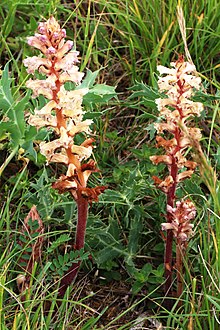Amethyst arum
| Amethyst arum | ||||||||||||
|---|---|---|---|---|---|---|---|---|---|---|---|---|

Amethyst summer root ( Orobanche amethystea ) |
||||||||||||
| Systematics | ||||||||||||
|
||||||||||||
| Scientific name | ||||||||||||
| Orobanche amethystea | ||||||||||||
| Thuill. |
The amethyst summer arum ( Orobanche amethystea ), also amethyst blue summer arum, is a species of the genus of summer arums ( Orobanche ) in the family of summer arums (Orobanchaceae).
Description and ecology
The amethyst summer root is a perennial herbaceous plant that reaches heights of 10 to 45 centimeters. It is a full parasite (holoparasite) that parasitizes on the field man litter ( Eryngium campestre ) . It does not form its own chlorophyll and does not photosynthesize .
The flowering period begins in mid-May and lasts until July, the fruit clusters can be seen until autumn. Older flowers protrude approximately horizontally. The unbranched stem , the bracts and the flowers are purple or purple in color. The inflorescence of younger specimens appears scaly because the bracts are longer than the flowers.
The hermaphrodite flowers are zygomorphic and five-fold with a double flower envelope . The calyx teeth are long pointed. The 18 to 21 millimeter long corolla is whitish and violet veined and its back line is more or less evenly curved. The yellow nectarium sits in a crescent shape around the attachment point of the stamens . The scar is purple or reddish brown.
The number of chromosomes is 2n = 38.
Occurrence and endangerment
The main distribution area of the amethyst summer root is Western Europe . Their distribution area extends from Morocco and Algeria to Portugal, Spain, France, Great Britain, Germany, Switzerland, Italy, the Balkan Peninsula, Iran and Afghanistan. It thrives in dry grass on dry, calcareous and moderately nutrient-rich soils . She is a character species of the Xerobromion Association. The amethyst summer root is bound to the rare occurrence of the host plant , field man litter ( Eryngium campestre ). The amethyst summer root is known in Baden-Württemberg in the Kraichgau , on the Kaiserstuhl and on the Bergstrasse , and it is said to be found in Rheinhessen as well . It is considered to be threatened with extinction (Baden-Württemberg Red List, Category 1).
Taxonomy
Orobanche amethystea was first published in 1799 by Jean-Louis Thuillier .
literature
- Oskar Sebald, Siegmund Seybold, Georg Philippi, Arno Wörz (eds.): The fern and flowering plants of Baden-Württemberg . tape 5 : Special part (Spermatophyta, subclass Asteridae): Buddlejaceae to Caprifoliaceae . Eugen Ulmer, Stuttgart (Hohenheim) 1996, ISBN 3-8001-3342-3 .
- Siegmund Seybold : Flora of Germany and neighboring countries. A book for identifying vascular plants that grow wild and often cultivated . Founded by Otto Schmeil , Jost Fitschen . 93rd completely revised and expanded edition. Quelle & Meyer, Wiebelsheim 2006, ISBN 3-494-01413-2 .
Individual evidence
- ↑ a b Erich Oberdorfer : Plant-sociological excursion flora for Germany and neighboring areas . With the collaboration of Angelika Schwabe and Theo Müller. 8th, heavily revised and expanded edition. Eugen Ulmer, Stuttgart (Hohenheim) 2001, ISBN 3-8001-3131-5 , pp. 867 .
- ^ Orobanche in the Germplasm Resources Information Network (GRIN), USDA , ARS , National Genetic Resources Program. National Germplasm Resources Laboratory, Beltsville, Maryland. Retrieved January 27, 2018.
Web links
- Orobanche amethystea Thuill., Amethyst summer root. In: FloraWeb.de.
- Amethyst arum . In: BiolFlor, the database of biological-ecological characteristics of the flora of Germany.
- Profile and distribution map for Bavaria . In: Botanical Information Hub of Bavaria .
- Thomas Meyer: Sommerwurz data sheet with identification key and photos at Flora-de: Flora von Deutschland (old name of the website: Flowers in Swabia ).


